Abstract
Under anaerobic conditions the sulfonated azo dye Mordant Yellow 3 was reduced by the biomass of a bacterial consortium grown aerobically with 6-aminonaphthalene-2-sulfonic acid. Stoichiometric amounts of the aromatic amines 6-aminonaphthalene-2-sulfonate and 5-aminosalicylate were generated and excreted into the medium. After re-aeration of the culture, these amines were mineralized by different members of the bacterial culture. Thus, total degradation of a sulfonated azo dye was achieved by using an alternating anaerobic-aerobic treatment. The ability of the mixed bacterial culture to reduce the azo dye was correlated with the presence of strain BN6, which possessed the ability to oxidize various naphthalenesulfonic acids. It is suggested that strain BN6 has a transport system for naphthalenesulfonic acids which also catalyzes uptake of sulfonated azo dyes. These dyes are then gratuitously reduced in the cytoplasm by unspecific reductases.
Full text
PDF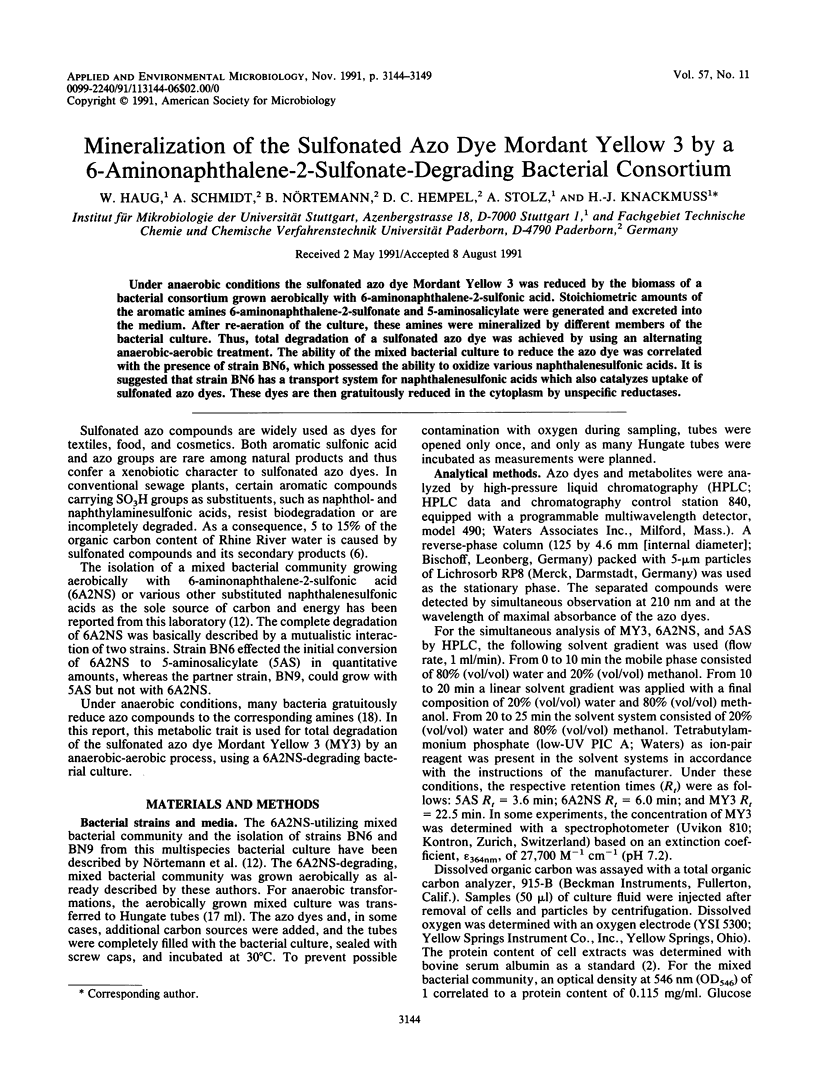
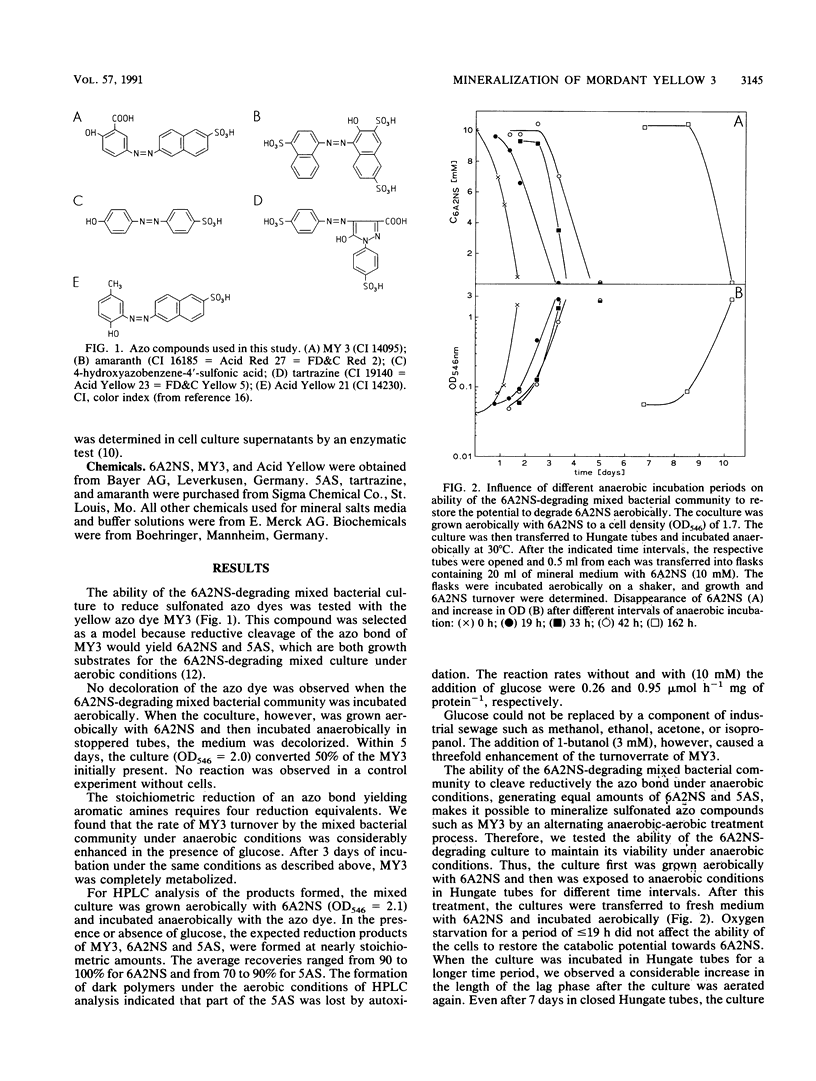
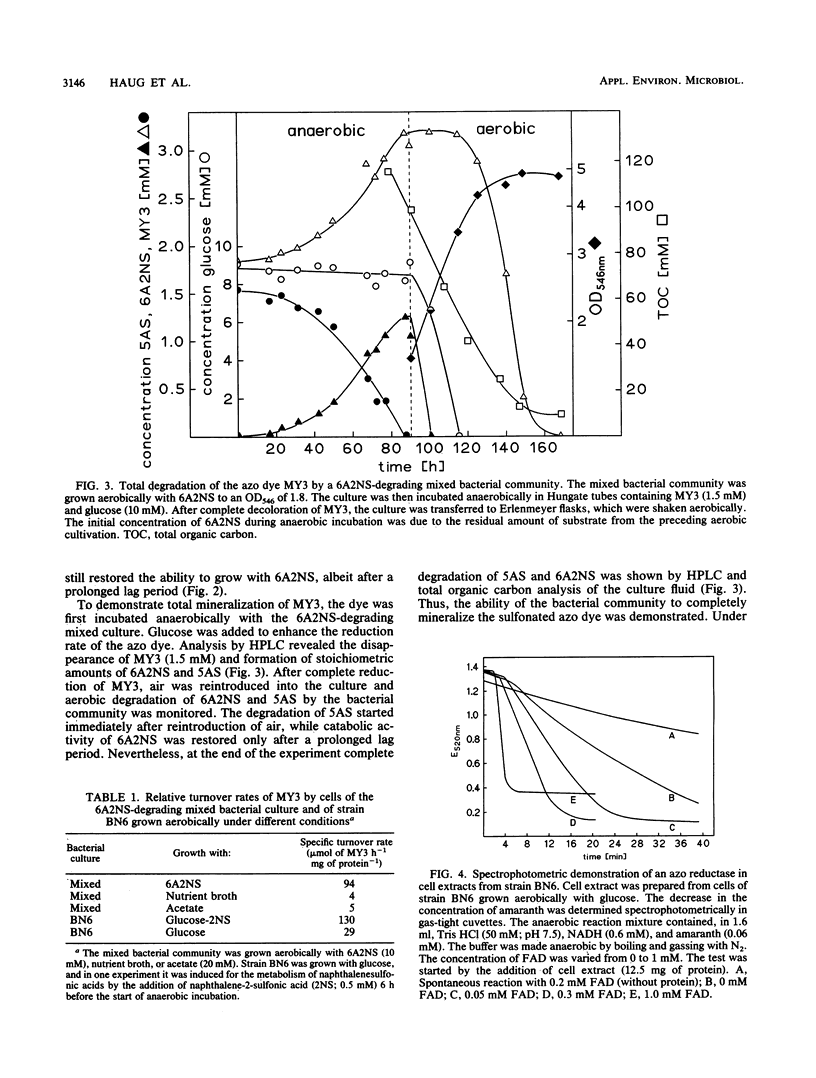
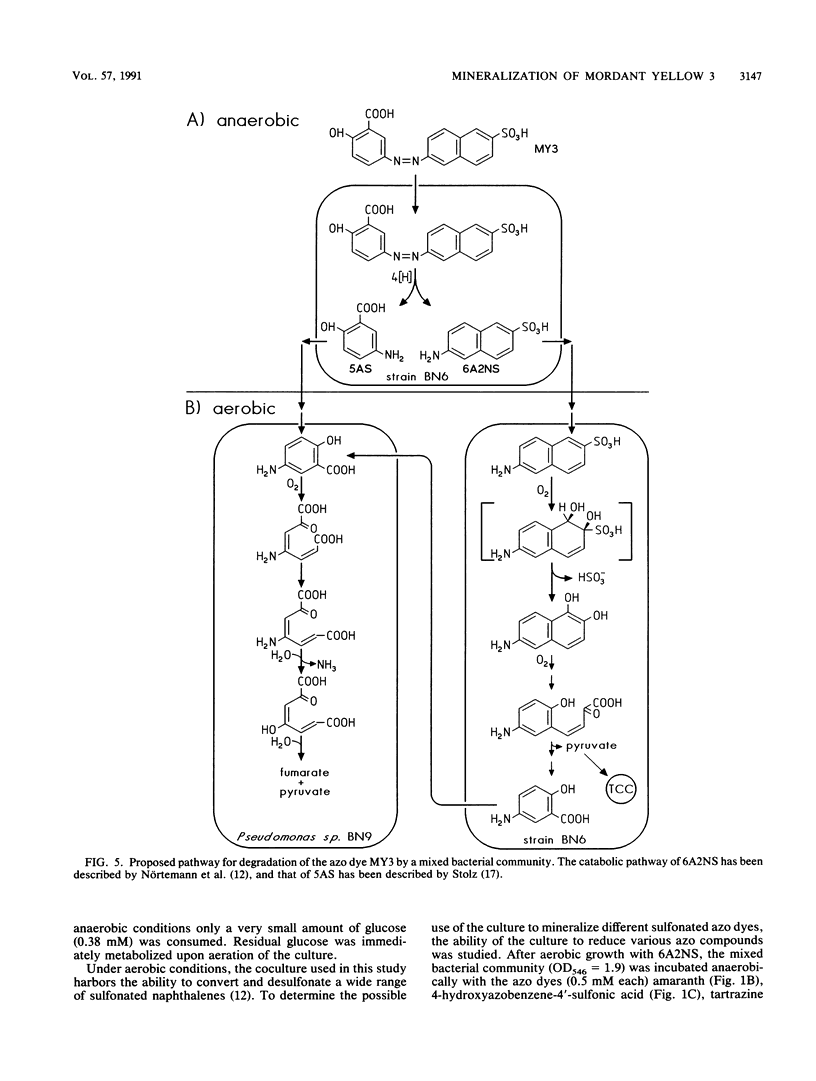
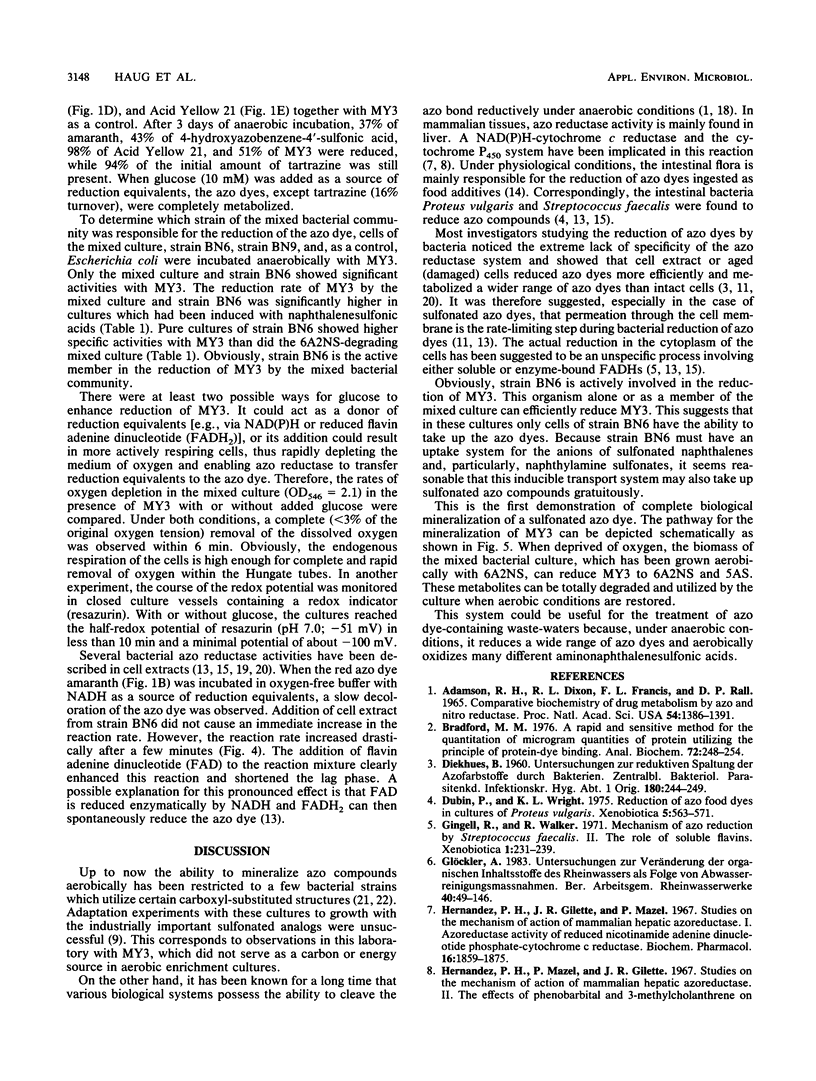
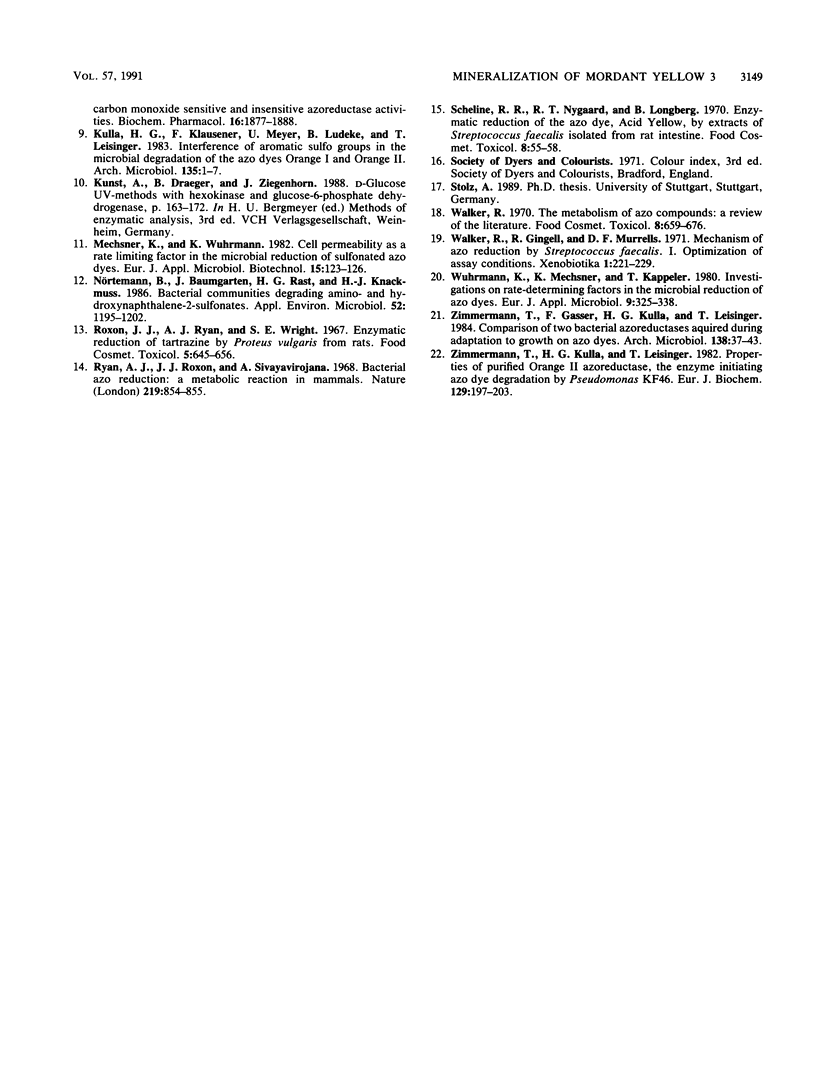
Selected References
These references are in PubMed. This may not be the complete list of references from this article.
- Adamson R. H., Dixon R. L., Francis F. L., Rall D. P. Comparative biochemistry of drug metabolism by azo and nitro reductase. Proc Natl Acad Sci U S A. 1965 Nov;54(5):1386–1391. doi: 10.1073/pnas.54.5.1386. [DOI] [PMC free article] [PubMed] [Google Scholar]
- Bradford M. M. A rapid and sensitive method for the quantitation of microgram quantities of protein utilizing the principle of protein-dye binding. Anal Biochem. 1976 May 7;72:248–254. doi: 10.1006/abio.1976.9999. [DOI] [PubMed] [Google Scholar]
- Dubin P., Wright K. L. Reduction of azo food dyes in cultures of Proteus vulgaris. Xenobiotica. 1975 Sep;5(9):563–571. doi: 10.3109/00498257509056126. [DOI] [PubMed] [Google Scholar]
- Gingell R., Walker R. Mechanisms of azo reduction by Streptococcus faecalis. II. The role of soluble flavins. Xenobiotica. 1971 May;1(3):231–239. doi: 10.3109/00498257109033172. [DOI] [PubMed] [Google Scholar]
- Hernandez P. H., Gillette J. R., Mazel P. Studies on the mechanism of action of mammalian hepatic azoreductase. I. Azoreductase activity of reduced nicotinamide adenine dinucleotide phosphate-cytochrome c reductase. Biochem Pharmacol. 1967 Oct;16(10):1859–1875. doi: 10.1016/0006-2952(67)90297-3. [DOI] [PubMed] [Google Scholar]
- Hernandez P. H., Mazel P., Gillette J. R. Studies on the mechanism of action of mammalian hepatic azoreductase. II. The effects of phenobarbital and 3-methylcholanthrene on carbon monoxide sensitive and insensitive azoreductase activities. Biochem Pharmacol. 1967 Oct;16(10):1877–1888. doi: 10.1016/0006-2952(67)90298-5. [DOI] [PubMed] [Google Scholar]
- Nörtemann B., Baumgarten J., Rast H. G., Knackmuss H. J. Bacterial communities degrading amino- and hydroxynaphthalene-2-sulfonates. Appl Environ Microbiol. 1986 Nov;52(5):1195–1202. doi: 10.1128/aem.52.5.1195-1202.1986. [DOI] [PMC free article] [PubMed] [Google Scholar]
- Roxon J. J., Ryan A. J., Wright S. E. Enzymatic reduction of tartrazine by Proteus vulgaris from rats. Food Cosmet Toxicol. 1967 Nov;5(5):645–656. doi: 10.1016/s0015-6264(67)83216-4. [DOI] [PubMed] [Google Scholar]
- Ryan A. J., Roxon J. J., Sivayavirojana A. Bacterial azo reduction: a metabolic reaction in mammals. Nature. 1968 Aug 24;219(5156):854–855. doi: 10.1038/219854a0. [DOI] [PubMed] [Google Scholar]
- Scheline R. R., Nygaard R. T., Longberg B. Enzymatic reduction of the azo dye, acid yellow, by extracts of Streptococcus faecalis isolated from rat intestine. Food Cosmet Toxicol. 1970 Feb;8(1):55–58. doi: 10.1016/s0015-6264(70)80223-1. [DOI] [PubMed] [Google Scholar]
- Walker R., Gingell R., Murrells D. F. Mechanisms of azo reduction by Streptococcus faecalis. I. Optimization of assay conditions. Xenobiotica. 1971 May;1(3):221–229. doi: 10.3109/00498257109033171. [DOI] [PubMed] [Google Scholar]
- Walker R. The metabolism of azo compounds: a review of the literature. Food Cosmet Toxicol. 1970 Dec;8(6):659–676. doi: 10.1016/s0015-6264(70)80455-2. [DOI] [PubMed] [Google Scholar]
- Zimmermann T., Gasser F., Kulla H. G., Leisinger T. Comparison of two bacterial azoreductases acquired during adaptation to growth on azo dyes. Arch Microbiol. 1984 May;138(1):37–43. doi: 10.1007/BF00425404. [DOI] [PubMed] [Google Scholar]
- Zimmermann T., Kulla H. G., Leisinger T. Properties of purified Orange II azoreductase, the enzyme initiating azo dye degradation by Pseudomonas KF46. Eur J Biochem. 1982 Dec;129(1):197–203. doi: 10.1111/j.1432-1033.1982.tb07040.x. [DOI] [PubMed] [Google Scholar]


